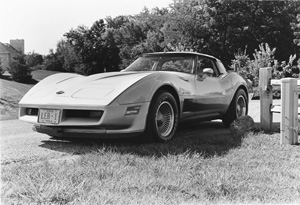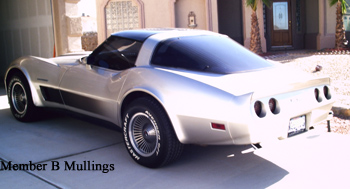
Chevrolet’s 1982 Corvette is more fuel efficient, yet has increased horsepower plus improved emission control and drivability.
Both the sport Coupe and Collector Edition Hatchback Coupe are equipped with Chevrolet’s fabled small-block V8 with new Cross Fire Injection (CFI), twin throttle-body injection electronic fuel metering system, and new four=speed overdrive automatic transmission. The results are improved performance, fuel economy, emission control and drivability. Manual shift ‘82s couldn’t pass EPA emissions test, making the ’82 Vette the first model since 1954 to be available with automatic transmission only.
The new model line – sport Coupe and special Collector Edition Hatchback Sport Coupe-is equipped with a 5.7 liter (350 cu.in.) V* engine rated at 200 horsepower. The engine delivers an estimated 15 miles per gallon in city driving, 26 highway. This compares with 1981, when the 5.7 liter engine was rated at 190 hp and had EPA fuel estimates of 15 mph city, 21 highway.
Cross-Fire Injection is a system of air and fuel control which includes two throttle body injection units, both controlled by the micro-computer. The units are mounted independently on the intake manifold cover and supply the correct air-fuel mixture to the manifold. Tuned runners in the manifold direct the mixture to cylinders on the opposite side of the engine. Thus, the name Cross-Fire Injection.
The on-board computer precisely meters fuel flow, which can be adjusted 80 time a second, compared with 10 times a second with the 1981 computer controlled carburetor. This metering accuracy under all vehicle operating conditions, regardless of temperature, humidity or atmospheric pressure, contributes to greater engine output and to improved economy, emissions and drivability.
The new induction system eliminates the need for the charcoal air cleaner element, the mechanical choke, and other fuel metering components, including idle speed control. A positive fuel shut-off prevents engine “dieseling.”
Unlike a carburetor, CFI provides a single metering circuit for coordinating the transition from idle to part throttle to wide open throttle operation.
The fuel system also features an electric motor driven twin turbine fuel pump, integral with the fuel tank metering unit. It supplies fuel at a positive pressure to the CFU units. A new in-line fuel filter contains a larger, more efficient paper filtering element. A new low-permeability fuel line minimizes evaporation losses. This fuel system aids cold start and is designed to prevent vapor lock
The new automatic four-speed overdrive transmission’s converter clutch engages in 2nd, 3rd, and 4th gears. Overdrive further boosts highway mileage.
A higher first gear ratio (3:07:1) improves off-the-line performance.
A solenoid-operated door at the front of the hood opens during wide-open throttle operation to duct fresh air directly into the air cleaner.
A new low-restriction exhaust system features a smaller and lighter wide-mouth catalytic converter. New insulated front pipes help reduce emissions by delivering hotter exhaust gas to the converter.
“This year we’ve added economy ad performance,” says David R. McLellan, Corvette chief engineer. “And it’s a harbinger of things to come, for the 1982 model is more than just the last of a generation; it’s Stage 1 of a two-stage production. We’re doing the power team this year. Next year, we add complete new styling and other innovations.”
There’s more than enough for the Corvette collector in 1982. In fact, the official 1982 Corvette Collector Edition will be available the entire year.
It’s a unique combination of color, equipment and innovation combined to produce one of the most comprehensive packages ever offered to the Corvette buyer,” McLellan said.
Perhaps the biggest change is a new frameless glass hatch, complete with remote release.M
The Collector Edition also includes:
· Exclusive silver-beige metallic color with distinctive decal treatment and pinstripes.
· Specific cloisonné emblems front, side and rear.
· Specific aluminum wheels and center hub, similar to the popular 1967 Corvette alloy wheels.
· Glass roof panels with special bronze color and solar creening.
The Collector Edition has matching silver beige metallic interior with multi-tone full leather seats and door trim. The Collector Edition theme is extended to the steering wheel, horn, console and instrument cluster trim plates.
Rear window defogger, power antenna and white letter Eagle GT radial tires are part of the Collector Edition package.
After 28 years in St. Louis, Corvette production has moved to Bowling Green, KY.
“The new plant utilizes advance automotive production techniques and the Corvette features advanced sports car technology-quite a parlay,” says David R. McLellan, Corvette chief engineer.
McLellan said the new paint process at the plant is the finest developed at GM.
The 1982 Corvette finish has scored as high as 95 on a “glossmeter” and that compares to a mirror reading of 100 percent.
“One might even say the all-new paint surface is a reflection of things to come in the auto industry,” McLellan said.
Each Corvette is given two coats of prime, followed by three coats of color for non-metallics and two coats of color and two cleat coats for metallics.
The clear finish contains a new sun-shield to help protect against paint oxidation caused by ultra-violet rays of the sun.
General Motors’ investment in this newer, more modern Corvette facility is clear evidence the future of the Corvette remains bright.
|
’82 VETTE FACTS
|
|
|
VEHICLE IDENTIFICATION NUMBER
|
1G1AY8786C5100001 to 1G1AY8786C512408. The first symbol (1) indicates US built. The second symbol (G) indicates GM product. The third symbol (1) indicates Chevrolet. The fourth symbol (A) indicates non-passive manual seat belts. The fifth symbol (Y) indicates car line or series (Corvette). The sixth and seventh symbols indicate the body style number 87 two-door plainback special coupe; 07 Collector Edition two-door hatchback coupe. The eighth symbol indicates engine: 8=5.7 liter Cross-Fire Injection (CFI) Chevrolet V8. The ninth symbol is a check digit that varies. The 10th symbol indicates model year (C=1982). The 11th symbol indicates the assembly plant: 5=Bowling Green. The last six symbols indicate the sequential production number starting with 100001
|
|
ENGINE
|
BASE ENGINE
Type: V-8
Bore and stroke: 4.00 x 3.48 in.
Displacement: 350 cid
Brake hp: 200 at 4200 rpm.
Induction: Cross-Fire fuel injection (twin TBI)
|
|
VITAL STATS
|
Coupe
Original Price: $18,290.07
Collector Coupe: $22,537.59
Production: 18,648 Coupe
6,759 Collector Coupe
Wheelbase: 98 in.
Length: 185.3 in.
Tires: P225/70-R-15 SBR/Collector P255/60R-15
|
|
COOL STUFF
|
• Last of the C3.
• Last model with optional radio packages that included an 8-track tape (UM4).
• Collector Edition first Corvette with a base price exceeding $20,000.
|